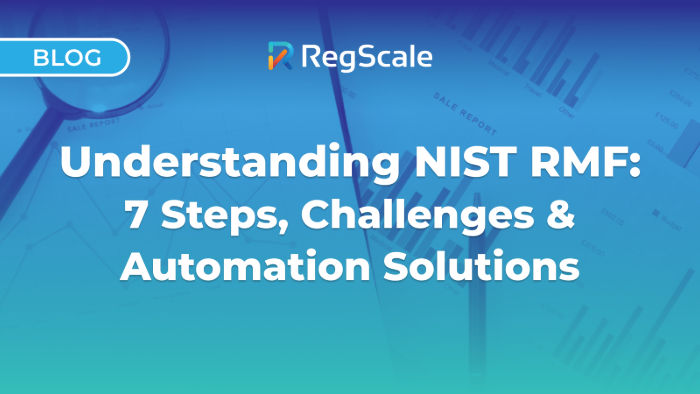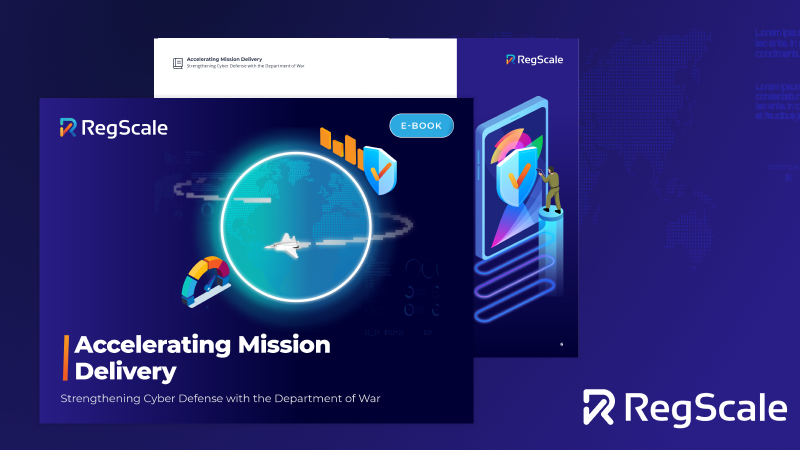Understanding NIST RMF: 7 Steps, Challenges & Automation Solutions

Let’s be honest: Managing cybersecurity risk across complex information systems is no joke. If you’re dealing with FISMA requirements or handling sensitive data, you already know the NIST Risk Management Framework is pretty much unavoidable.
But here’s what’s frustrating: even organizations that understand the RMF can struggle to implement it without getting bogged down in bureaucracy.
The pressure is real. Federal agencies are under constant scrutiny for their security posture, Department of Defense contractors are sweating over ATO renewals, and everyone’s trying to figure out how to handle ongoing challenges like supply chain risk and efficiency mandates without increasing the burden on staff.
So how do you get from compliance headache to security advantage? It starts with understanding not just what the NIST RMF requires but also how to make it work for your organization instead of against it. Today, we’ll explain the framework in detail, including its history, implementation challenges, best practices, and more.
About the NIST Risk Management Framework (RMF)
If you’ve ever wondered how federal agencies and organizations keep their information systems secure without drowning in bureaucracy, the answer is the NIST Risk Management Framework. Think of it as the gold standard for cybersecurity risk management: a structured yet flexible approach that helps organizations protect their digital assets while actually getting things done.
A Brief History Lesson on NIST RMF
The RMF didn’t just appear overnight. The National Institute of Standards and Technology (NIST) developed the RMF from the Federal Information Security Modernization Act (FISMA) requirements for federal agencies. It also evolved from earlier NIST guidance, particularly the certification and accreditation processes that many found cumbersome and outdated.
The current version, outlined in NIST Special Publication 800-37 Revision 2, represents years of refinement based on real-world feedback from federal agencies and private organizations.
What makes this framework unique is that it integrates security, privacy, and supply chain risk management into the system development life cycle from day one. Instead of treating cybersecurity as an afterthought, the RMF weaves it into every phase of how organizations build, deploy, and maintain their information systems.
Today, the RMF continues to evolve with the threat landscape. Recent updates include NIST releasing SP 1314, the RMF Small Enterprise Quick Start Guide, in July 2024 to introduce the RMF to small, under-resourced entities. The result is a disciplined process for managing security controls and privacy controls across an organization’s federal information systems.
Ready to dive into how this actually works in practice? Let’s break down the specific steps that make the RMF tick.
What Are the Risk Management Framework Steps?
The NIST Risk Management Framework guides organizations through seven steps: Prepare, Categorize, Select, Implement, Assess, Authorize, and Monitor. Each step builds systematically on the previous one, creating a logical progression from initial prep to ongoing monitoring. This iterative approach distinguishes the RMF from static compliance frameworks and supports dynamic risk management processes for changing risk environments.
Step 1: Prepare. First, companies need to define their risk tolerance, establish their governance structures, and determine how the RMF will integrate with their existing risk management processes. This step involves identifying key stakeholders, establishing an organizational risk management strategy, and preparing the necessary resources and infrastructure to support the framework implementation.
Step 2: Categorize. Second, organizations have to classify their information systems based on the potential impact that a compromise could have on data confidentiality, integrity, and availability.
Step 3: Select. Next comes choosing the appropriate security controls and privacy controls based on the system categorization from Step 2. Organizations should reference NIST SP 800-53 to identify control baselines and tailor them to their specific security requirements. They should also consider supply chain risk management controls and address privacy risks that may impact the system.
Step 4: Implement. Implementation focuses both on deploying the selected controls and on documenting how each control is implemented. To do so, organizations must coordinate across teams, assign responsibilities, and develop system security and privacy plans that detail control implementation.
Step 5: Assess. Next, businesses have to conduct a security controls assessment to determine whether controls are implemented correctly and operating as intended. Here, independent assessors evaluate control effectiveness, identify vulnerabilities, and document findings. This assessment feeds into the overall system security evaluation and helps determine the organization’s security posture.
Step 6: Authorize. Authorization represents the formal decision by a senior official to accept the security and residual risk of operating a system. Based on assessment results and residual risk analysis, the authorizing official grants an Authorization to Operate (ATO).
Step 7: Monitor. The final step establishes continuous monitoring of security controls, system security, and organizational risk so that businesses can maintain situational awareness of the security status. This step supports ongoing mitigation of emerging threats and ensures that security and privacy protections remain effective throughout the system’s entire operational life cycle.
RMF Implementation Challenges and Best Practices
While the NIST RMF provides a solid roadmap for managing cybersecurity risk, putting it into practice can be challenging. Federal agencies and other organizations often find themselves wrestling with real-world constraints like tight deadlines and limited resources that make textbook implementation feel nearly impossible.
Let’s look at what typically trips people up. Understanding these common obstacles can help organizations navigate the complexities of RMF adoption more effectively.
Resource and Expertise Constraints: First, a reality check: RMF implementation isn’t something you can wing. The framework demands deep knowledge across risk assessment, security controls selection, and continuous monitoring. Agencies can face obstacles like resource constraints and the need for extensive training, and many will discover they’re missing critical expertise just when they need it most — especially teams tackling structured risk management for the first time.
Documentation Overload: The RMF’s thoroughness can work against you if you’re not careful. Organizations often get overwhelmed trying to document every detail of their information systems and controls. Between security controls assessment requirements, impact analysis, and ongoing documentation needs, it’s easy to get buried in so much paperwork that the actual security work grinds to a halt.
Breaking Old Habits: There’s a need to shift from a “checkbox compliance” mindset to a more holistic approach to risk management — a shift we’re constantly advocating for at RegScale. Organizations must move beyond viewing RMF as a compliance exercise and embrace it as a fundamental component of their organizational risk management strategy. This cultural transformation requires leadership commitment and sustained change management efforts.
Integration with Existing Systems: Fitting RMF into your existing system development life cycle and risk management processes — without breaking what already works — is like solving a puzzle where half the pieces keep changing shape. Legacy systems, established workflows, and existing procedures all need to mesh with new RMF requirements, and that’s rarely as straightforward as it sounds on paper.
Best Practices for Successful Implementation
Get Leadership on Board (And Keep Them There). You can’t fake your way through RMF implementation; it needs real organizational commitment. Your best bet is to set up cross-functional teams that actually include people from IT, security, privacy, and business units who can make decisions. More importantly, you’ll want to nail down your risk tolerance levels early and make sure everyone understands them. When tough calls need to be made later, you’ll be glad you laid this groundwork.
Start Monitoring from Day One. Don’t wait until Step 7 to think about continuous monitoring. The organizations that struggle most are the ones who treat monitoring as an afterthought, so you’ll want to build those capabilities early. That way, you can actually see what’s happening with your system security in real time and catch vulnerabilities as they emerge.
Don’t Ignore Your Supply Chain. Supply chain risk management isn’t optional anymore. Your security is only as strong as your weakest vendor, so extend your risk management thinking beyond what you directly control. It’s more work up front, but implementing ongoing assessments and strict security protocols for vendors and supply chain partners beats explaining a breach that came through a third party.
Privacy Isn’t an Add-On. Modern RMF implementation means dealing with privacy risks right alongside security concerns. Don’t treat privacy controls as something to bolt on later; weave them into your control selection and implementation from the start. Data protection requirements aren’t getting any simpler, so the sooner you build them into your process, the better.
Have a Plan for When Things Go Wrong. Spoiler alert: your assessments will turn up issues. Develop your remediation and mitigation strategies before you start testing, not after. Know how you’ll handle vulnerabilities, update your Plan of Action and Milestones (POA&M), and prevent findings from turning into months-long bottlenecks.
Automate What You Can. Manual RMF processes don’t scale, period. Invest in tools that handle automated control assessment, continuous monitoring, and documentation management so your team isn’t trapped copying and pasting data between spreadsheets.
The bottom line? Treat RMF as an ongoing capability you’re building, not a one-time project you’re checking off a list. Organizations that focus on continuous improvement, invest in the right tools and training, and keep their eye on their overall security posture gain a lot more value from the framework.
Conclusion: Streamlining the RMF Process with RegScale
Let’s face it: Implementing the NIST RMF manually is like trying to manage a complex project with sticky notes and spreadsheets. It works until it doesn’t, and then you’re stuck explaining why your ATO is delayed again. This is where purpose-built solutions like RegScale make a real difference.
RegScale takes the pain out of RMF processes by automating every single step of the framework — from preparing and categorizing all the way through continuous monitoring. Instead of wrestling with manual control testing and documentation, you get real-time control testing powered by AI that integrates seamlessly with your existing security and DevOps tools.
As a founding member of the NIST OSCAL Foundation, we bring serious federal government compliance expertise to the table. Our FedRAMP High Authorized platform isn’t just another compliance tool; it’s built specifically for the complexities that federal agencies and contractors face when managing cybersecurity risk at scale.
The bottom line is simple: RMF implementation doesn’t have to be a compliance nightmare. With the right automation platform, you can move from checkbox exercises to genuine continuous monitoring that actually future-proofs your risk management program.
Ready to get started?
Choose the path that is right for you!
Skip the line
My organization doesn’t have GRC tools yet and I am ready to start automating my compliance with continuous monitoring pipelines now.
Supercharge
My organization already has legacy compliance software, but I want to automate many of the manual processes that feed it.
